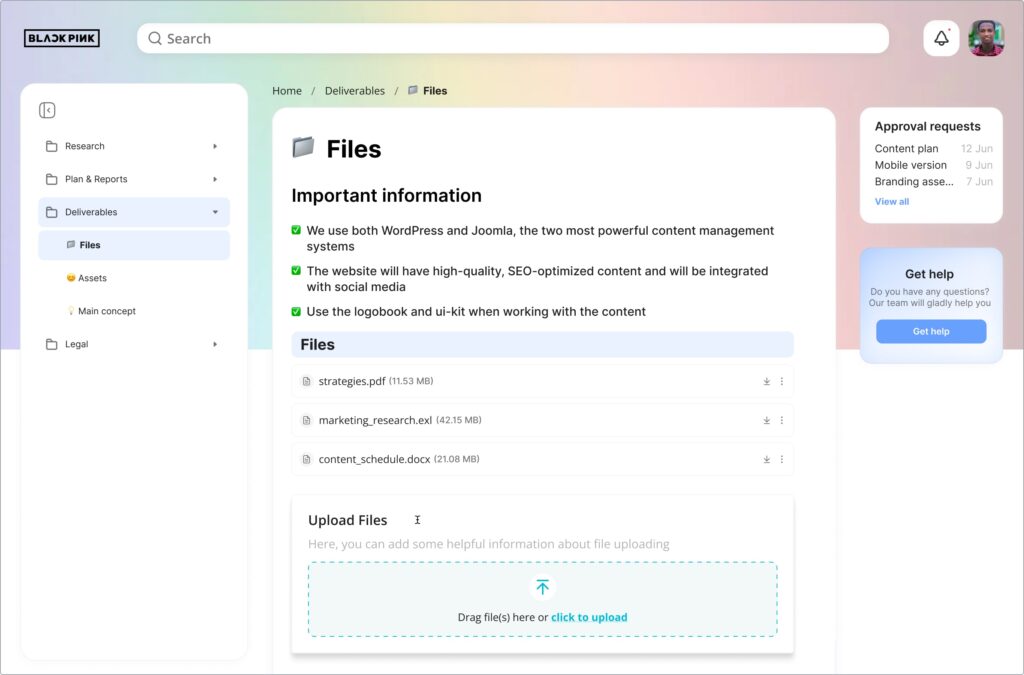
How to Improve Company Documentation and Make it Pop
- 11 Min read
Use all of the power of super documents with our experts
Book a demoAt work, you will deal with different kinds of documents, files and media. Texts, images and videos surround you all day while you’re working on a particular project. We interact with different files to share feedback, make edits and suggestions, organize information and perform dozens of other actions.
However, working with different types of content can be tiring and time-consuming as you need various tools for viewing, editing or commenting. Few companies (and few employees) know how to make this process more convenient and time-efficient.
That’s because they probably haven’t heard about interactive documents. What are they? And what type of content do they support? Do you need extra file readers or tools to work with them properly? If you need answers to these and other questions, you landed on the right page. Keep reading to learn more about interactive documents and how they can help you ace working with any kind of content at work!
Interactive documents contain various types of content and media formats. Usually, such document types include video and audio together with text files, links and images. One of the main perks of such files is that you can easily edit them and incorporate any kind of multimedia that supports the most popular file formats.

Interactive documents mainly help in industries such as marketing, sales, education, or design, as they create a better picture of what should be drawn, created, written or shot. You can use such files to share references or give more context to your requirements or briefs. Also, they allow you to present a new product or a particular feature more vividly and understandably.
This is what makes interactive documents universal, so you can use them for practically any occasion: from better information management to creating briefs for your clients.
Interactive documents serve a variety of functions. They’re pretty useful at work and help to add all the necessary information into a single document your clients and employees would enjoy looking at. Here’s a list of key benefits for using interactive content for your projects and daily tasks:
Your document will look much easier and more comprehensive to read and navigate, thanks to new visual elements. Tables of content, some images, tables, or videos will make a document much more attractive. Also, such elements help to visualize information easier and convey an overall idea of a product or feature you present.
Having extra content in a document like a hyperlink, table, or explainer video helps bring more clarity. Whether it’s for a product, a new feature or a company, it’s essential to make the document appealing, enjoyable to explore and straightforward. Having extra visual interactive content can significantly help.
It can be hard to concentrate when you see a lot of text in a document. Some eye-catching elements like images, buttons and even GIFs can motivate readers to keep looking through the file. Moreover, infographics and other types of visual content are easier to digest than plain text.
People usually don’t remember what they’ve read on your brochure or a website, but they remember what you made them feel. So, creating interactive documents for your target audience will help develop a particular image around your brand. Plus, it’ll help your company keep up with your desired tone of voice and evoke necessary emotions among your users.
Reading huge bulks of text with no visual elements can be pretty hard. You wouldn’t want to offer such documents to new employees getting to know the company or your potential clients who wish to learn more about your products. It’s easier to watch an interactive video or get some information from a chart or infographic.
Bright, branded presentations will help you look more professional and gain more trust among your clients. In addition, a comprehensive PDF containing charts, videos and buttons will help your employees get a structured, well-formatted collection of data they can easily perceive.
Putting all the necessary materials in one place (especially if it’s just one document) significantly shortens the time spent searching for particular data. This helps employees stay productive and focus on more critical tasks.
Since there are various types of interactive documents (e.g., handbooks, reviews, reports, etc.), you can produce countless types of engaging, catchy materials. This makes users get back to you for more insightful content and find out more about your business, especially if you’re creating a series of interactive documents. That would force users to wait for another iteration of a handbook and eventually make them make a purchase on your website.
Interactive documents, unlike regular text files, have a broader scope of usage and have way more features. Let’s look at the most valuable elements you should add to your interactive files to help with your everyday workload and ensure effective cooperation with your clients and coworkers.
Contact or feedback forms, questionnaires, and polls are among the most used interactive add-ons you can incorporate into your file. You can add a script, a link to a form or a widget that would engage readers to answer a few quick questions. You can use interactive content as forms to get feedback, collect contact information from potential clients or sponsors, get new ideas or segment your current audience.
Create forms and interact on them with your clients and teams right in FuseBase!
If you have to create a brief document but still need to provide sufficient information about your product, a new feature or a company in general, hyperlinks will come in handy. They’ll forward your client, business partner or coworkers to a relevant website or file to provide more clarity. At the same time, you will not overload the general file with piles of text and excessive information. You can easily embed hyperlinks in your interactive Word files, Google Docs or PDFs.
Animations and visual transitions add a creative touch to your documents and decrease the cognitive load for readers. Plus, you can create your own animations to show how a tool or app works, where to click, how to use a feature, process a payment or perform any other action. Adding more visual context to your interactive content is always a good idea as you can vividly demonstrate how to work with a particular app or service.
Traditional embedded content like videos, images or audio files also adds more context and allows document viewers to get a better idea of what your future product, speech or presentation will be about. You can add embedded interactive content such as explainer videos, infographics, voice recording drafts, etc. You can share such media to gather feedback from your colleagues and help others understand your ideas better.
Buttons are eye-catching and help you easily direct people to whatever page or file you need. Buttons inspire readers to click on them if they’re well-designed and contain a proper call to action that resonates with the file’s core message. You can add a button to ask people to watch a demo, request a quote, find out more information on your website and so on. Use proper coloring, fonts and placement to ensure you’ll get more people to click on them.
To make the most out of using interactive documents and become more productive at work, we’ve prepared some useful tips to help you out. With these tips, you’ll create informative and engaging documents your clients and employees will enjoy.
Having too many visuals is as bad as adding huge pieces of text as it creates quite a cluttered and uninformative interactive document. Find spots where it’s logical to put an infographic, a video, or a button, insert relevant hyperlinks, and you’ll get a balanced, visually appealing interactive document.
Trying new kinds of visuals and incorporating them into your documents can help increase the file’s clarity and level of perception. Run some tests to see what templates would work better for your colleagues, which ones look more comprehensive, and what designs would be the best option for your clients. Having a unified template for each kind of interactive document is unnecessary, so you can change and improve templates from time to time.
Having a structured piece of information facilitates navigation and makes searching for particular data way faster and more convenient for readers. To help you with that, you can add tables of content with linked points in the text, headings and subheadings. Plus, you can also add a FAQ section or a list of key points people can find in the presentation. This will improve clarity and help users avoid wasting time looking for necessary information.
Adding corporate colors to your documents will make your company stand out among the competitors. In addition, this will add more professionalism and style to your documents. It’s also fine to add your company’s website address or contact information so potential customers or partners can easily reach out to you.
If you still haven’t implemented interactive documents into your everyday work or want to enhance the way they look and work for your team, one of the most convenient and helpful options to use is FuseBase (formerly Nimbus). This collaboration tool allows you to create, edit, manage and combine multi-format documents, making them interactive.
Create your first interactive document in minutes with FuseBase!
One of the best features to help you with interactive files is Super Documents. It allows you to add all kinds of media in a single file: videos, audio recordings, images, emojis and more. FuseBase (formerly Nimbus) also allows you to insert screen-sharing videos, voice messages and pre-recorded presentations in any document, whether it’s interactive or not.
All these features, together with an intuitive design and useful add-ons, improve the experience of using interactive documents and open up plenty of opportunities for collaboration. So, try FuseBase for free and feel the difference!
Join FuseBase Twitter page to stay updated on our latest articles and updates!
Found it useful? Share the article with your community
Get weekly tips and insights on how to grow your business